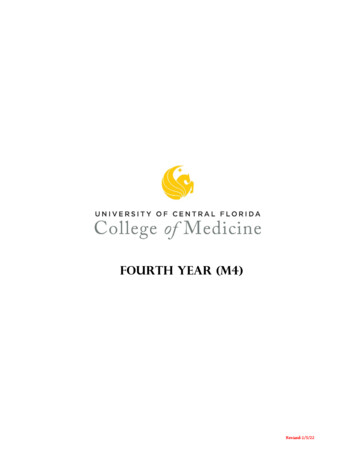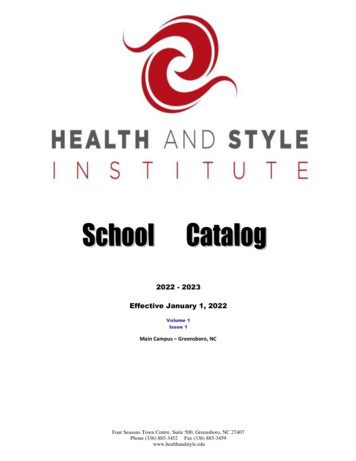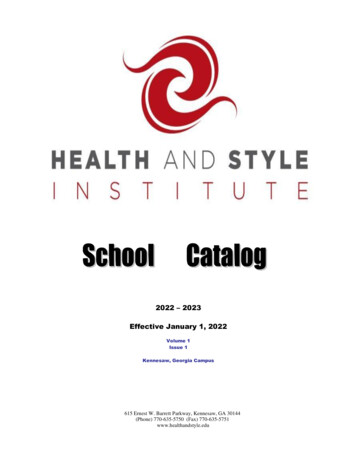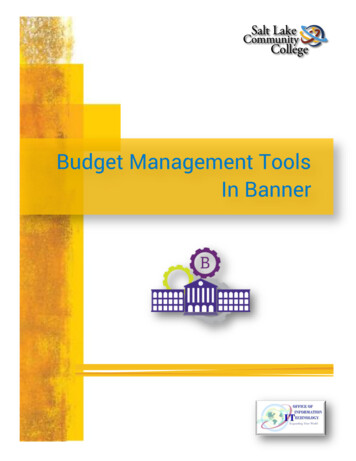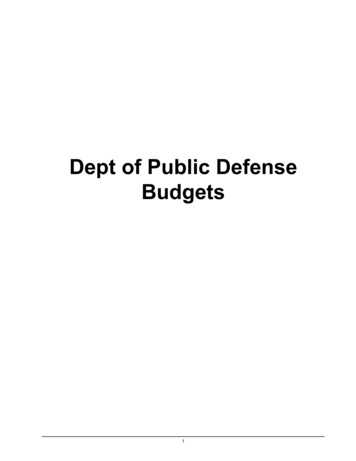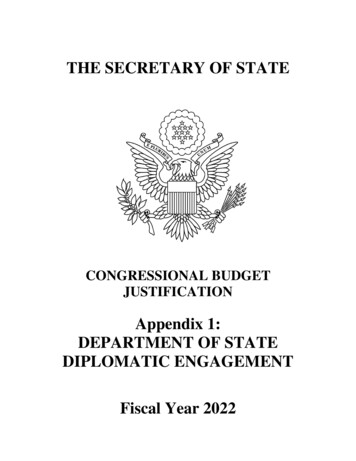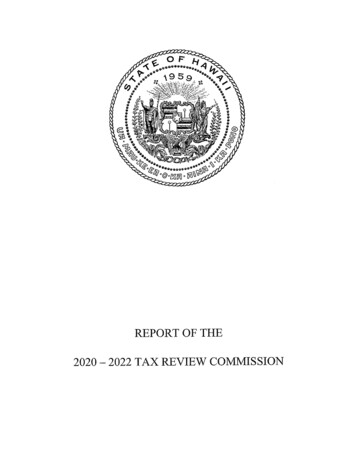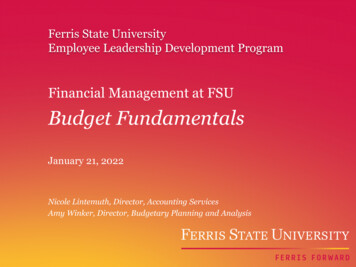
Transcription
GOVERNMENT OF INDIABUDGET 2022-2023SPEECHOFNIRMALA SITHARAMANMINISTER OF FINANCEFebruary 1, 2022
CONTENTSPART-A IntroductionPM GatiShaktiInclusive DevelopmentProductivity Enhancement & Investment, Sunrise Opportunities, EnergyTransition & Climate ActionFinancing of InvestmentsFiscal ManagementPage No.135111720PART BDirect Tax Proposals Introducing new ‘Updated return’ Reduced Alternate minimum tax rate and Surcharge for Cooperatives Tax relief to persons with disability Parity between employees of State and Central government Incentives for Start-ups Incentives for newly incorporated manufacturing entities underconcessional tax regime Scheme for taxation of virtual digital assets Litigation management to avoid repetitive appeals by the Department Tax incentives to IFSC Rationalization of Surcharge Clarification in relation to ‘Health and Education cess’ as businessexpenditure Deterrence against tax-evasion: Rationalizing TDS Provisions21Indirect Taxes Remarkable progress in GST: Special Economic Zones: Customs Reforms and duty rate changes Project imports and capital goods Review of customs exemptions and tariff simplification Electronics Gems and Jewellery Chemicals: MSME Exports Tariff measure to encourage blending of fuel25AnnexuresAnnexures to Part A of the Speech Initial list of projects under PM DevINE Statement of Extra Budgetary Resources (EBRs) (Govt. fully servicedbonds, NSSF loan and other resources)3031
Budget 2022-2023Speech ofNirmala SitharamanMinister of FinanceFebruary 1, 2022Hon’ble Speaker,I present the Budget for the year 2022-23.Introduction1.At the outset, I want to take a moment to express my empathy forthose who had to bear adverse health and economic effects of thepandemic.2.The overall, sharp rebound and recovery of the economy is reflectiveof our country’s strong resilience. India’s economic growth in the currentyear is estimated to be 9.2 per cent, highest among all large economies.3.I recognise we are in the midst of an Omicron wave, with highincidence, but milder symptoms. Further, the speed and coverage of ourvaccination campaign has helped greatly. With the acceleratedimprovement of health infrastructure in the past two years, we are in astrong position to withstand challenges. I am confident that with SabkaPrayas we will continue our journey of strong growth.4.Hon’ble Speaker, we are marking Azadi ka Amrit Mahotsav, andhave entered into Amrit Kaal, the 25-year-long leadup to India@100.Hon’ble Prime Minister in his Independence Day address had set-out thevision for India@100.5.By achieving certain goals during the Amrit Kaal, our governmentaims to attain the vision. They are: Complementing the macro-economic level growth focus with amicro-economic level all-inclusive welfare focus,
2 Promoting digital economy & fintech, technology enableddevelopment, energy transition, and climate action, and Relying on virtuous cycle starting from private investment withpublic capital investment helping to crowd-in privateinvestment.6.Since 2014 our government’s focus has been on empowerment ofcitizens, especially the poor and the marginalised. Measures have includedprogrammes that have provided housing, electricity, cooking gas, andaccess to water. We also have programmes for ensuring financial inclusionand direct benefit transfers. We are committed to strengthening theabilities of the poor to tap all opportunities. Our government constantlystrives to provide the necessary ecosystem for the middle classes – a vastand wide section which is populated across various middle-income brackets– to make use of the opportunities they so desire.7.This Budget seeks to lay the foundation and give a blueprint to steerthe economy over the Amrit Kaal of the next 25 years – from India at 75 toIndia at 100. It continues to build on the vision drawn in the Budget of 202122. Its fundamental tenets, which included transparency of financialstatement and fiscal position, reflect the government’s intent, strengths,and challenges. This continues to guide us.8.The initiatives of the last year’s Budget have seen significantprogress and have been provided with adequate allocations in this Budgetas well.9.The strengthening of health infrastructure, speedy implementationof the vaccination programme, and the nation-wide resilient response tothe current wave of the pandemic, are evident for all.10.The Productivity Linked Incentive in 14 sectors for achieving thevision of AtmaNirbhar Bharat has received excellent response, withpotential to create 60 lakh new jobs, and an additional production of 30lakh crore during next 5 years.11.Towards implementation of the new Public Sector Enterprise policy,the strategic transfer of ownership of Air India has been completed. Thestrategic partner for NINL (Neelanchal Ispat Nigam Limited) has beenselected. The public issue of the LIC is expected shortly. Others too are inthe process for 2022-23.
312.The National Bank for Financing Infrastructure and Development(NaBFID) and National Asset Reconstruction Company have commencedtheir activities.13.Hon'ble Speaker sir, Budget 2021-22 had provided a sharp increasein provision for public investment or capital expenditure. Throughout theyear, with the Hon'ble Prime Minister, guiding the implementation, oureconomic recovery is continuing to benefit from the multiplier effect.14.This Budget continues to provide impetus for growth. It lays aparallel track of (1) a blueprint for the Amrit Kaal, which is futuristic andinclusive. This will directly benefit our youth, women, farmers, theScheduled Castes and the Scheduled Tribes. And (2) big public investmentfor modern infrastructure, readying for India at 100. This shall be guided byPM GatiShakti and be benefited by the synergy of multi-modal approach.Moving forward, on this parallel track, we lay the following four priorities: PM GatiShakti Inclusive Development Productivity Enhancement & Investment, SunriseOpportunities, Energy Transition, and Climate Action Financing of InvestmentsPM GatiShakti15.PM GatiShakti is a transformative approach for economic growthand sustainable development. The approach is driven by seven engines,namely, Roads, Railways, Airports, Ports, Mass Transport, Waterways, andLogistics Infrastructure. All seven engines will pull forward the economy inunison. These engines are supported by the complementary roles of EnergyTransmission, IT Communication, Bulk Water & Sewerage, and SocialInfrastructure. Finally, the approach is powered by Clean Energy and SabkaPrayas – the efforts of the Central Government, the state governments, andthe private sector together – leading to huge job and entrepreneurialopportunities for all, especially the youth.PM GatiShakti National Master Plan16.The scope of PM GatiShakti National Master Plan will encompass theseven engines for economic transformation, seamless multimodalconnectivity and logistics efficiency. It will also include the infrastructuredeveloped by the state governments as per the GatiShakti Master Plan. The
4focus will be on planning, financing including through innovative ways, useof technology, and speedier implementation.17.The projects pertaining to these 7 engines in the NationalInfrastructure Pipeline will be aligned with PM GatiShakti framework. Thetouchstone of the Master Plan will be world-class modern infrastructureand logistics synergy among different modes of movement – both of peopleand goods – and location of projects. This will help raise productivity, andaccelerate economic growth and development.Road Transport18.PM GatiShakti Master Plan for Expressways will be formulated in2022-23 to facilitate faster movement of people and goods. The NationalHighways network will be expanded by 25,000 km in 2022-23. 20,000crore will be mobilized through innovative ways of financing to complementthe public resources.Seamless Multimodal Movement of Goods and People19.The data exchange among all mode operators will be brought onUnified Logistics Interface Platform (ULIP), designed for ApplicationProgramming Interface (API). This will provide for efficient movement ofgoods through different modes, reducing logistics cost and time, assistingjust-in-time inventory management, and in eliminating tediousdocumentation. Most importantly, this will provide real time information toall stakeholders, and improve international competitiveness. Open-sourcemobility stack, for organizing seamless travel of passengers will also befacilitated.Multimodal Logistics Parks20.Contracts for implementation of Multimodal Logistics Parks at fourlocations through PPP mode will be awarded in 2022-23.Railways21.Railways will develop new products and efficient logistics servicesfor small farmers and Small and Medium Enterprises, besides taking thelead in integration of Postal and Railways networks to provide seamlesssolutions for movement of parcels.22.‘One Station-One Product’ concept will be popularized to help localbusinesses & supply chains.
523.As a part of Atmanirbhar Bharat, 2,000 km of network will bebrought under Kavach, the indigenous world-class technology for safety andcapacity augmentation in 2022-23. Four hundred new-generation VandeBharat Trains with better energy efficiency and passenger riding experiencewill be developed and manufactured during the next three years.24.One hundred PM GatiShakti Cargo Terminals for multimodal logisticsfacilities will be developed during the next three years.Mass Urban Transport including Connectivity to Railways25.Innovative ways of financing and faster implementation will beencouraged for building metro systems of appropriate type at scale.Multimodal connectivity between mass urban transport and railwaystations will be facilitated on priority. Design of metro systems, includingcivil structures, will be re-oriented and standardized for Indian conditionsand needs.Parvatmala: National Ropeways Development Programme26.As a preferred ecologically sustainable alternative to conventionalroads in difficult hilly areas, National Ropeways Development Programmewill be taken up on PPP mode. The aim is to improve connectivity andconvenience for commuters, besides promoting tourism. This may alsocover congested urban areas, where conventional mass transit system is notfeasible. Contracts for 8 ropeway projects for a length of 60 km will beawarded in 2022-23.Capacity Building for Infrastructure Projects27.With technical support from the Capacity Building Commission,central ministries, state governments, and their infra-agencies will havetheir skills upgraded. This will ramp up capacity in planning, design,financing (including innovative ways), and implementation management ofthe PM GatiShakti infrastructure projects.Inclusive DevelopmentAgriculture28.The procurement of wheat in Rabi 2021-22 and the estimatedprocurement of paddy in Kharif 2021-22 will cover 1208 lakh metric tonnesof wheat and paddy from 163 lakh farmers, and 2.37 lakh crore directpayment of MSP value to their accounts.
629.Chemical-free Natural Farming will be promoted throughout thecountry, with a focus on farmers’ lands in 5-km wide corridors along riverGanga, at the first stage.30.2023 has been announced as the International Year of Millets.Support will be provided for post-harvest value addition, enhancingdomestic consumption, and for branding millet products nationally andinternationally.31.To reduce our dependence on import of oilseeds, a rationalised andcomprehensive scheme to increase domestic production of oilseeds will beimplemented.32.For delivery of digital and hi-tech services to farmers withinvolvement of public sector research and extension institutions along withprivate agri-tech players and stakeholders of agri-value chain, a scheme inPPP mode will be launched.33.Use of ‘Kisan Drones’ will be promoted for crop assessment,digitization of land records, spraying of insecticides, and nutrients.34.States will be encouraged to revise syllabi of agricultural universitiesto meet the needs of natural, zero-budget and organic farming, modern-dayagriculture, value addition and management.35.A fund with blended capital, raised under the co-investment model,will be facilitated through NABARD. This is to finance startups foragriculture & rural enterprise, relevant for farm produce value chain. Theactivities for these startups will include, inter alia, support for FPOs,machinery for farmers on rental basis at farm level, and technologyincluding IT-based support.Ken Betwa project and Other River Linking Projects36.Implementation of the Ken-Betwa Link Project, at an estimated costof 44,605 crore will be taken up. This is aimed at providing irrigationbenefits to 9.08 lakh hectare of farmers’ lands, drinking water supply for 62lakh people, 103 MW of Hydro, and 27 MW of solar power. Allocations of 4,300 crore in RE 2021-22 and 1,400 crore in 2022-23 have been made forthis project.37.Draft DPRs of five river links, namely Damanganga-Pinjal, Par-TapiNarmada, Godavari-Krishna, Krishna-Pennar and Pennar-Cauvery have been
7finalized. Once a consensus is reached among the beneficiary states, theCentre will provide support for implementation.Food Processing38.For farmers to adopt suitable varieties of fruits and vegetables, andto use appropriate production and harvesting techniques, our governmentwill provide a comprehensive package with participation of stategovernments.MSME39.Udyam, e-Shram, NCS and ASEEM portals will be interlinked. Theirscope will be widened. They will now perform as portals with live, organicdatabases, providing G2C, B2C and B2B services. These services will relateto credit facilitation, skilling, and recruitment with an aim to furtherformalise the economy and enhance entrepreneurial opportunities for all.40.Emergency Credit Line Guarantee Scheme (ECLGS) has providedmuch-needed additional credit to more than 130 lakh MSMEs. This hashelped them mitigate the adverse impact of the pandemic. The hospitalityand related services, especially those by micro and small enterprises, areyet to regain their pre-pandemic level of business. Considering theseaspects, the ECLGS will be extended up to March 2023 and its guaranteecover will be expanded by 50,000 crore to total cover of 5 lakh crore,with the additional amount being earmarked exclusively for the hospitalityand related enterprises.41.Credit Guarantee Trust for Micro and Small Enterprises (CGTMSE)scheme will be revamped with required infusion of funds. This will facilitateadditional credit of 2 lakh crore for Micro and Small Enterprises andexpand employment opportunities.42.Raising and Accelerating MSME Performance (RAMP) programmewith outlay of 6,000 crore over 5 years will be rolled out. This will help theMSME sector become more resilient, competitive and efficient.Skill Development43.Skilling programmes and partnership with the industry will bereoriented to promote continuous skilling avenues, sustainability, andemployability. The National Skill Qualification Framework (NSQF) will bealigned with dynamic industry needs.
844.Digital Ecosystem for Skilling and Livelihood – the DESH-Stack eportal – will be launched. This aims to empower citizens to skill, reskill orupskill through on-line training. It will also provide API-based trusted skillcredentials, payment and discovery layers to find relevant jobs andentrepreneurial opportunities.45.Startups will be promoted to facilitate ‘Drone Shakti’ through variedapplications and for Drone-As-A-Service (DrAAS). In select ITIs, in all states,the required courses for skilling, will be started.Universalization of Quality Education46.Due to the pandemic-induced closure of schools, our children,particularly in the rural areas, and those from Scheduled Castes andScheduled Tribes, and other weaker sections, have lost almost 2 years offormal education. Mostly, these are children in government schools. Werecognise the need to impart supplementary teaching and to build aresilient mechanism for education delivery. For this purpose, ‘one class-oneTV channel’ programme of PM eVIDYA will be expanded from 12 to 200 TVchannels. This will enable all states to provide supplementary education inregional languages for classes 1-12.47.In vocational courses, to promote crucial critical thinking skills, togive space for creativity, 750 virtual labs in science and mathematics, and 75skilling e-labs for simulated learning environment, will be set-up in 2022-23.48.High-quality e-content in all spoken languages will be developed fordelivery via internet, mobile phones, TV and radio through Digital Teachers.49.A competitive mechanism for development of quality e-content bythe teachers will be set-up to empower and equip them with digital tools ofteaching and facilitate better learning outcomes.Digital University50.A Digital University will be established to provide access to studentsacross the country for world-class quality universal education withpersonalised learning experience at their doorsteps. This will be madeavailable in different Indian languages and ICT formats. The University willbe built on a networked hub-spoke model, with the hub building cuttingedge ICT expertise. The best public universities and institutions in thecountry will collaborate as a network of hub-spokes.
9Ayushman Bharat Digital Mission51.An open platform, for the National Digital Health Ecosystem will berolled out. It will consist of digital registries of health providers and healthfacilities, unique health identity, consent framework, and universal accessto health facilities.National Tele Mental Health Programme52.The pandemic has accentuated mental health problems in people ofall ages. To better the access to quality mental health counselling and careservices, a ‘National Tele Mental Health Programme’ will be launched. Thiswill include a network of 23 tele-mental health centres of excellence, withNIMHANS being the nodal centre and International Institute of InformationTechnology-Bangalore (IIITB) providing technology support.Mission Shakti, Mission Vatsalya, Saksham Anganwadi & Poshan 2.053.Recognizing the importance of Nari Shakti as the harbinger of ourbright future and for women-led development during the Amrit Kaal, ourgovernment has comprehensively revamped the schemes of the Ministry ofWomen & Child Development. Accordingly, three schemes, namely,Mission Shakti, Mission Vatsalya, Saksham Anganwadi and Poshan 2.0 werelaunched recently to provide integrated benefits to women andchildren. Saksham Anganwadis are a new generation anganwadis that havebetter infrastructure and audio-visual aids, powered by clean energy andproviding improved environment for early child development. Two lakhanganwadis will be upgraded under the Scheme.Har Ghar, Nal Se Jal54.Current coverage of Har Ghar, Nal Se Jal is 8.7 crores. Of this 5.5crore households were provided tap water in last 2 years itself. Allocation of 60,000 crore has been made with an aim to cover 3.8 crore households in2022-23.Housing for All55.In 2022-23 80 lakh houses will be completed for the identifiedeligible beneficiaries of PM Awas Yojana, both rural and urban. 48,000crore is allocated for this purpose.56.The Central Government will work with the state governments forreduction of time required for all land and construction related approvals,for promoting affordable housing for middle class and Economically Weaker
10Sections in urban areas. We shall also work with the financial sectorregulators to expand access to capital along with reduction in cost ofintermediation.Prime Minister’s Development Initiative for North East Region (PMDevINE)57.A new scheme, Prime Minister’s Development Initiative for NorthEast, PM-DevINE, will be implemented through the North-Eastern Council. Itwill fund infrastructure, in the spirit of PM GatiShakti, and socialdevelopment projects based on felt needs of the North-East. This willenable livelihood activities for youth and women, filling the gaps in varioussectors. It will not be a substitute for existing central or state schemes.While the central ministries may also pose their candidate projects, prioritywill be given to those posed by the states. An initial allocation of 1,500crore will be made, and the initial list of projects is given in Annexure-1.Aspirational Blocks Programme58.Our vision to improve the quality of life of citizens in the mostbackward districts of the country through Aspirational Districts Programmehas been translated into reality in a short span of time. 95 per cent of those112 districts have made significant progress in key sectors such as health,nutrition, financial inclusion and basic infrastructure. They have surpassedthe state average values. However, in those districts, some blocks continueto lag. In 2022-23, the programme will focus on such blocks in thosedistricts.Vibrant Villages Programme59.Border villages with sparse population, limited connectivity andinfrastructure often get left out from the development gains. Such villageson the northern border will be covered under the new Vibrant VillagesProgramme. The activities will include construction of village infrastructure,housing, tourist centres, road connectivity, provisioning of decentralizedrenewable energy, direct to home access for Doordarshan and educationalchannels, and support for livelihood generation. Additional funding forthese activities will be provided. Existing schemes will be converged. We willdefine their outcomes and monitor them on a constant basis.Anytime – Anywhere Post Office Savings60.In 2022, 100 per cent of 1.5 lakh post offices will come on the corebanking system enabling financial inclusion and access to accounts through
11net banking, mobile banking, ATMs, and also provide online transfer offunds between post office accounts and bank accounts. This will be helpful,especially for farmers and senior citizens in rural areas, enabling interoperability and financial inclusion.Digital Banking61.In recent years, digital banking, digital payments and fintechinnovations have grown at a rapid pace in the country. Government iscontinuously encouraging these sectors to ensure that the benefits of digitalbanking reach every nook and corner of the country in a consumer-friendlymanner. Taking forward this agenda, and to mark 75 years of ourindependence, it is proposed to set up 75 Digital Banking Units (DBUs) in 75districts of the country by Scheduled Commercial Banks.Digital Payments62.The financial support for digital payment ecosystem announced inthe previous Budget will continue in 2022-23. This will encourage furtheradoption of digital payments. There will also be a focus to promote use ofpayment platforms that are economical and user friendly.Productivity Enhancement & Investment, Sunrise Opportunities, EnergyTransition, and Climate ActionProductivity Enhancement & InvestmentEase of Doing Business 2.0 & Ease of Living63.In recent years, over 25,000 compliances were reduced and 1486Union laws were repealed. This is the result of our government’s strongcommitment for ‘minimum government & maximum governance’, our trustin the public, and ease of doing business (EODB).64.For the Amrit Kaal, the next phase of Ease of Doing Business EODB2.0 and Ease of Living, will be launched. In our endeavour to improveproductive efficiency of capital and human resources, we will follow theidea of ‘trust-based governance’.65.This new phase will be guided by an active involvement of thestates, digitisation of manual processes and interventions, integration of thecentral and state-level systems through IT bridges, a single point access forall citizen-centric services, and a standardization and removal ofoverlapping compliances. Crowdsourcing of suggestions and ground level
12assessment of the impact with active involvement of citizens and businesseswill be encouraged.Green Clearances66.A single window portal, PARIVESH, for all green clearances waslaunched in 2018. It has been instrumental in reducing the time required forapprovals significantly. The scope of this portal will now be expanded, toprovide information to the applicants. Based on location of units,information about specific approvals will be provided. It will enableapplication for all four approvals through a single form, and tracking of theprocess through Centralized Processing Centre-Green (CPC-Green).e-Passport67.The issuance of e-Passports using embedded chip and futuristictechnology will be rolled out in 2022-23 to enhance convenience for thecitizens in their overseas travel.Urban Development68.By the time of India @ 100, nearly half our population is likely to beliving in urban areas. To prepare for this, orderly urban development is ofcritical importance. This will help realize the country’s economic potential,including livelihood opportunities for the demographic dividend. For this, onthe one hand we need to nurture the megacities and their hinterlands tobecome current centres of economic growth. On the other hand, we needto facilitate tier 2 and 3 cities to take on the mantle in the future. Thiswould require us to reimagine our cities into centres of sustainable livingwith opportunities for all, including women and youth. For this to happen,urban planning cannot continue with a business-as-usual approach. We planto steer a paradigm change.69.A high-level committee of reputed urban planners, urbaneconomists and institutions will be formed to make recommendations onurban sector policies, capacity building, planning, implementation andgovernance.Urban Planning Support to States70.For urban capacity building, support will be provided to the states.Modernization of building byelaws, Town Planning Schemes (TPS), andTransit Oriented Development (TOD) will be implemented. This willfacilitate reforms for people to live and work closer to mass transit systems.
13The Central Government’s financial support for mass transit projects andAMRUT scheme will be leveraged for formulation of action plans and theirimplementation for facilitating TOD and TPS by the states.71.For developing India specific knowledge in urban planning anddesign, and to deliver certified training in these areas, up to five existingacademic institutions in different regions will be designated as centres ofexcellence. These centres will be provided endowment funds of 250 croreeach. In addition, AICTE will take the lead to improve syllabi, quality andaccess of urban planning courses in other institutions.Clean & Sustainable Mobility72.We will promote a shift to use of public transport in urban areas.This will be complemented by clean tech and governance solutions, specialmobility zones with zero fossil-fuel policy, and EV vehicles.Battery Swapping Policy73.Considering the constraint of space in urban areas for setting upcharging stations at scale, a battery swapping policy will be brought out andinter-operability standards will be formulated. The private sector will beencouraged to develop sustainable and innovative business models for‘Battery or Energy as a Service’. This will improve efficiency in the EV ecosystem.Land Records Management74.Efficient use of land resources is a strong imperative. States will beencouraged to adopt Unique Land Parcel Identification Number to facilitateIT-based management of records. The facility for transliteration of landrecords across any of the Schedule VIII languages will also be rolled out.75.The adoption or linkage with National Generic DocumentRegistration System (NGDRS) with the ‘One-Nation One-RegistrationSoftware’ will be promoted as an option for uniform process for registrationand ‘anywhere registration’ of deeds & documents.Insolvency and Bankruptcy Code76.Necessary amendments in the Code will be carried out to enhancethe efficacy of the resolution process and facilitate cross border insolvencyresolution.
14Accelerated Corporate Exit77.Several IT-based systems have been established for acceleratedregistration of new companies. Now the Centre for Processing AcceleratedCorporate Exit (C-PACE) with process re-engineering, will be established tofacilitate and speed up the voluntary winding-up of these companies fromthe currently required 2 years to less than 6 months.Government Procurement78.Government rules have recently been modernized for the needs theAmrit Kaal. The new rules have benefitted from the inputs from variousstakeholders. The modernised rules allow use of transparent quality criteriabesides cost in evaluation of complex tenders. Provisions have been madefor payment of 75 per cent of running bills, mandatorily within 10 days andfor encouraging settlement of disputes through conciliation.79.As a further step to enhance transparency and to reduce delays inpayments, a completely paperless, end-to-end online e-Bill System will belaunched for use by all central ministries for their procurements. Thesystem will enable the suppliers and contractors to submit online theirdigitally signed bills and claims and track their status from anywhere.80.To reduce indirect cost for suppliers and work-contractors, the useof surety bonds as a substitute for bank guarantee will be made acceptablein government procurements. Business such as gold imports may also findthis useful. IRDAI has given the framework for issue of surety bonds byinsurance companies.AVGC Promotion Task Force81.The animation, visual effects, gaming, and comic (AVGC) sectoroffers immense potential to employ youth. An AVGC promotion task forcewith all stakeholders will be set-up to recommend ways to realize this andbuild domestic capacity for serving our markets and the global demand.Telecom Sector82.Telecommunication in general, and 5G technology in particular, canenable growth and offer job opportunities. Required spectrum auctions willbe conducted in 2022 to facilitate rollout of 5G mobile services within 202223 by private telecom providers.83.A scheme for design-led manufacturing will be launched to build astrong ecosystem for 5
It continues to build on the vision drawn in the Budget of 2021-22. Its fundamental tenets, which included transparency of financial statement and fiscal position, reflect the government's intent, strengths, and challenges. This continues to guide us. 8. The initiatives of the last year's Budget have seen significant .
